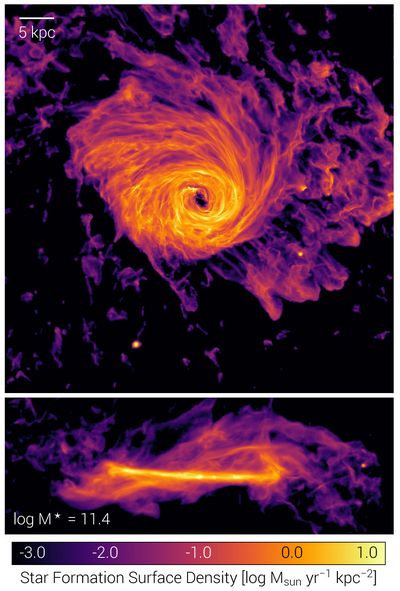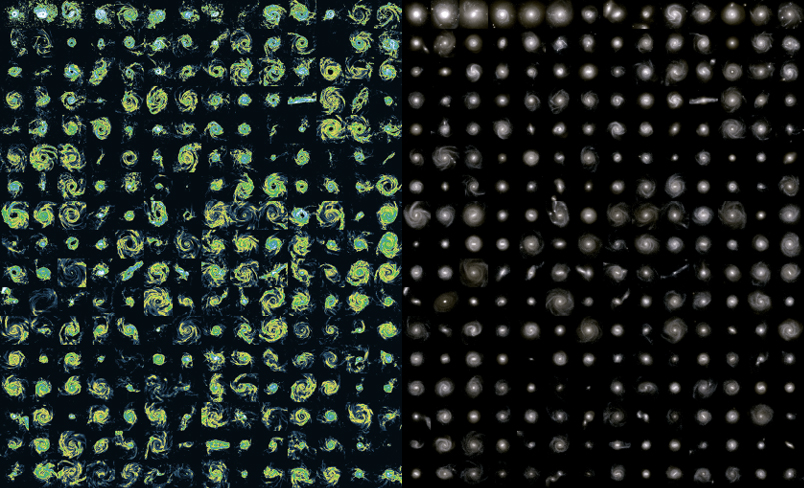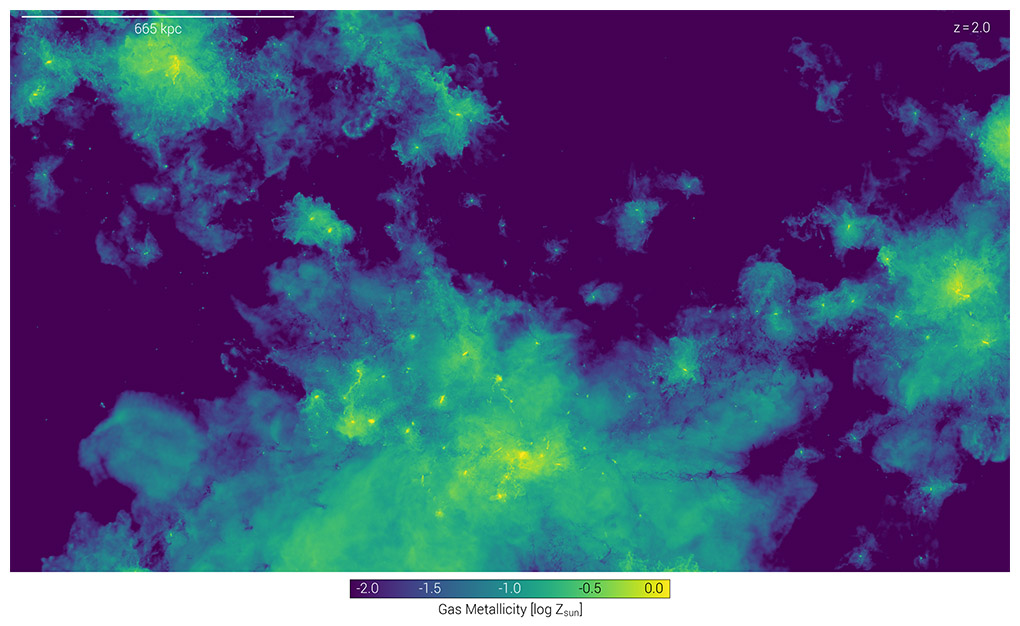ASTROPHYSICS
Simulating the Universe: Predictive Galaxy Formation towards the Smallest Scales
Principal Investigator:
Dylan Nelson(1) and Annalisa Pillepich(2)
Affiliation:
(1) MPA Garching (Germany), (2) MPIA Heidelberg (Germany)
Local Project ID:
GCS-dwar
HPC Platform used:
Hazel Hen of HLRS
Date published:
Observed galaxies today range in mass from a few thousand to a few trillion times the mass of the sun, encompass physical sizes from a few hundred to tens of thousands of light-years across, and come in variety of shapes or ‘morphologies’. Galaxies reside in diverse environments -- in isolation, or as members of crowded groups and clusters. Their distribution throughout space traces a `cosmic web' defined by filaments and voids of matter. This clustered large-scale structure of the Universe today arose from 13.8 billion years of evolution, starting from the nearly uniform distribution of matter shortly after the Big Bang.
To test this scenario, and to understand the formation and evolution of the multitude of galaxies we see when we look out into the night sky, we need precise theoretical predictions. Because the light which reaches us arises from stars, diffuse gas, and accreting black holes, numerical simulations which directly evolve these three components of normal matter, in addition to dark matter and dark energy, are crucial. These calculations require models for the most important astrophysical processes, such as the formation of stars and the collapse of gas into seed black holes which subsequently grow into supermassive gravitational wells. We must also model the ensuing release of huge amounts of energy from these objects, including the spectacular deaths of stars via supernovae explosions, and the ultra-fast outflows driven away from black holes, both of which can shape the formation and evolution of entire galaxies.
The TNG50 simulation is the third and final effort of the IllustrisTNG project, so-called because it follows the evolution of a region of space roughly fifty million parsecs (163 million light-years) across. Undertaken by an international team and jointly lead by PIs Dr. Dylan Nelson (MPA Garching) and Dr. Annalisa Pillepich (MPIA Heidelberg), it leverages the newly developed TNG model for galaxy formation physics, as included in all three simulations of the IllustrisTNG project.
This galaxy formation model produces a simulated Universe with many properties which are consistent with astronomical data. For instance, IllustrisTNG contains galaxies similar in size and shape to real galaxies. The amount of heavy elements produced by stars and distributed into the interstellar gas agrees well with nearby observations from the Sloan Digital Sky Survey. The total number of stars in galaxies, their distribution throughout space, and how rapidly new stars are being born are all reasonable. The TNG model also captures one of the most important stages in the evolution of a galaxy, when it terminates its ongoing star formation. This shifts the light emitted by a galaxies’ stars to longer, redder wavelengths, and we also find that the dichotomy of ‘red’ versus ‘blue’ galaxy colors as a function of their mass agrees well with observations. According to IllustrisTNG, the only mechanism capable of quenching star formation in large galaxies is the huge amounts of energy released by the supermassive black holes at their center.
The galaxies in TNG50 are evolved from just after the Big Bang to the present day, with an unprecedented resolution for such a large cosmological volume. This detail enables studies of the internal structure of individual galaxies. Since TNG50 includes galaxies over a wide range of masses, direct predictions for the signatures observable with the James Webb Space Telescope (JWST), which is expected to launch in 2020, can be made. For example, the image above shows a single disk-like galaxy with complex spiral features, when the Universe was about half its current age, face-on (top) and edge-on (bottom). The color indicates the rate that new, young stars are forming out of interstellar gas, a quantity which we can measure with telescopes including JWST by looking for the radiation emitted by excited states of metal ions such as oxygen, magnesium, and iron.
The TNG50 simulation includes not just one such galaxy, but thousands. In the image above, for example, we show about 240 examples, decreasing in mass from the upper left to the lower right corner. For each galaxy, the distribution of its gas (on the left) is contrasted against the expected stellar light (on the right) – the two are similar in many cases, though not always. By simulating full galaxy populations in large cosmological volumes we are able to make statistically robust comparisons against observational surveys. This enables us to constrain our theoretical models, as well as to interpret and guide observations of not only ‘typical’ galaxies, but also of rare, interesting objects.
By coupling a large, cosmological volume with high, sub-galactic resolution, we can also study the interplay between the two. A particularly striking signature of this interaction lies in the production of heavy elements (called ‘metals’), which are produced by individual stars deep inside galaxies throughout their lifetimes. Some metals can then be ejected to large distances by energetic, high-velocity winds or outflows from galaxies, thereby polluting the intergalactic medium (IGM) which is the dilute, low-density gas filling the space between galaxies. For example, the image below shows the expected distribution of gas metallicity (the ratio of heavy elements to hydrogen and helium) on large scales: the scale-bar marks 665 kiloparsecs, or about two million lightyears. The color highlights highly enriched regions, yellow denoting gas as metal-rich as our own present day Sun, which traces the locations of individual galaxies. In purple are regions of space with only 1%, or less, as much enriched gas. In the intermediary, we see that large volumes of intergalactic space are partially enriched to different degrees – we can measure this distribution observationally by analyzing how individual atoms absorb the light of even more distant background light sources, like dusty clouds in front of a bright flashlight.
The mathematical equations governing the physical processes relevant for galaxy formation are non-linear, complex, and highly coupled. As a result, computational methods are required, and the computational challenges are significant. To realize TNG50, continual development efforts have led to a highly efficient version of the parallel astrophysics code AREPO, which was then used on the Hazel Hen machine at the High-Performance Computing Center Stuttgart (HLRS). TNG50 is the most computationally demanding project of its kind ever undertaken – it uses 16,000 processors in parallel, running for more than 9 months straight, 24 hours a day, to follow the simultaneous formation of millions of galaxies. The tightly coupled nature of the problem requires constant, fast communication between these machines, and the TNG50 simulation would have not been possible without the high-performance computing (HPC) resources of the Gauss Center for Supercomputing (GCS). Upon completion, the simulation will produce several hundreds of terabytes of data, which will provide a laboratory for open-ended studies of galaxy formation and cosmology for years to come.
Scientific Contact:
Dr. Dylan Nelson
Max Planck Institute for Astrophysics
Karl-Schwarzschild-Strasse 1, D-85748 Garching (Germany)
e-mail: dnelson [@] MPA-Garching.MPG.DE
Web page of the Illustris-TNG project (with further visualizations and videos)
Project ID: GCS_dwar
May 2018


